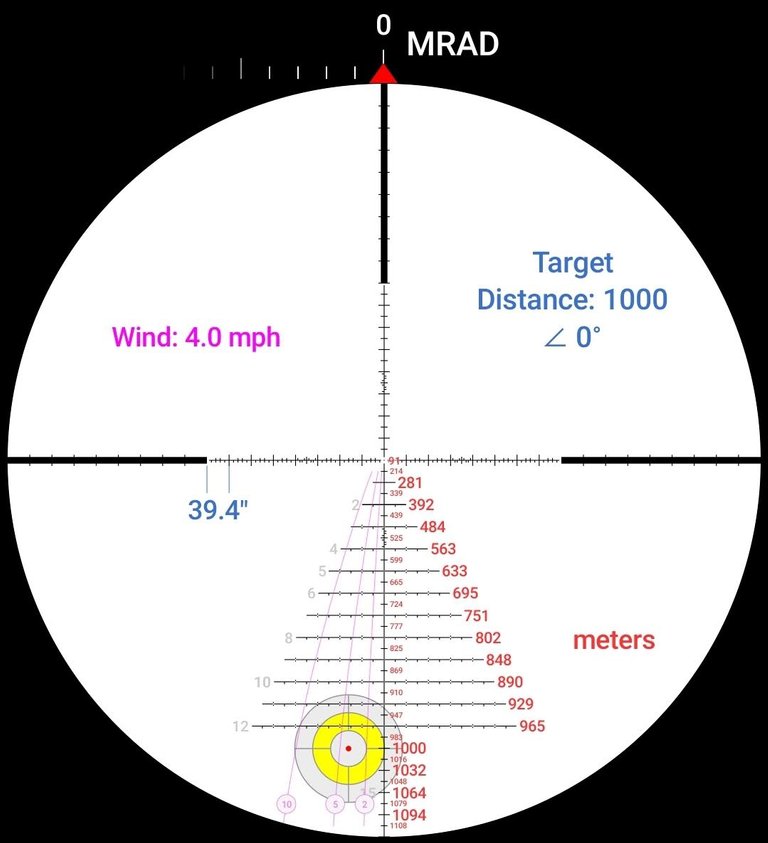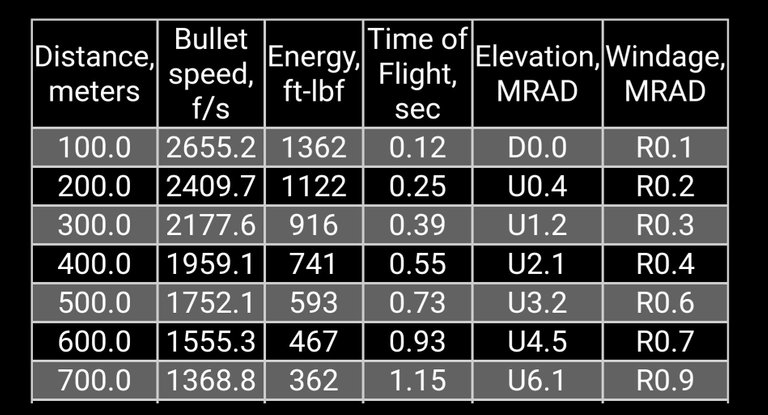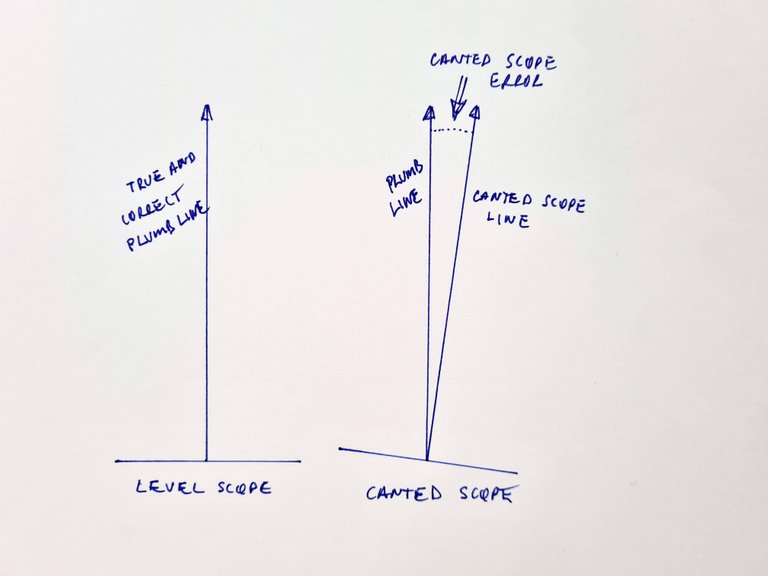For some, "levelling up" means reaching a new level on a computer game but for me it's much different. You see, as a long range shooter levelling is a critical part of sending accurate shots downrange. I thought I'd talk a little about it today and show you how I achieve it.
As always, I won't get too technical and explain only the very basics so here goes.

The reticle
You'll probably know that when we look through a scope, we typically see a cross hairs which is what we aim on when sending rounds down range. This is actually called the reticle and typically looks like a cross. You can see one below, one of my scopes, taken from my ballistics calculator. Ignore the red numbers and the...The reticle is the black cross and the Christmas tree thing, also in black. This is off my Kahles 624i 6-24x56 scope, which uses the SKMR reticle in MRAD.

When we need to reach our further in distance we dial elevation adjustments into the elevation turret on the top of the scope. I use the MRAD measurement. As the elevation input is added it moves the point of aim accordingly, typically up, but down if the targets are closer again. So, if I was shooting at a closer range I would input less elevation and at greater distance I would input more elevation so the bullet arcs into the target and, indeed, reaches it. It's a simple concept.
This is demonstrated below in the simple chart I created off my ballistics calculator to show you.
- 100m no elevation required as I have my rifle zeroed at 100m.
- 300m requires 1.2 MRAD of elevation
- 700m requires 6.1 MRAD of elevation

Of course a lot of factors change the amount of adjustment required, but I won't go into that here. Also, I would have the distance intervals set to 25m not 100m, but again, it demonstrates a point - Shooting over greater distances requires more elevation.
With that in mind, and assuming I was taking a 700m shot, I would simply dial in 6.1 MRAD of elevation, aim at the centre of the cross hairs (reticle) and shoot right? Wrong.
This is where rifle level comes into play.
Assuming my rifle was exactly level to the earth...I *don't mean the ground, or platform I have it resting on, I mean the Earth, the above principle works. Dial up and shoot.
But here's the thing...If the rifle is leaning one way, let's say to the right, even slightly, there's big problems - Most likely problems that will result in a miss; I'll explain.
The lean I mention above is actually called cant. The rifle is canted one way or the other, not dead level to the Earth. No shooter could ever get it perfect and mostly some cant is always present, yes, even when the shooter, in his hubris, thinks it's not.
What happens when the rifle is canted one way, and I dial elevation, is that the scope actually dials the cross hairs away from the target, not up to it. This will result in a miss.
The basic diagram below explains it. (Sorry, technical drawing isn't my thing.)
- On the left you see a true and correct level scope. The elevation input can be added and the scope tracks upwards on a true plumb-line.
- On the right you see a scope canted to the right, exaggerated for the sake of the drawing. When the elevation is dialled up the scope tracks upwards but in the direction of the cant and so away from the plumb-line. That shot will clearly miss the target. You can see the error in the trajectory at the top. Depending on the range this could be many, many inches of error.

The simple fix
Because nothing in nature is really level, or plumb, and often buildings are not either, the long range shooter relies on a simply tool to find a level position from which to take the shot, no matter if they are on very uneven ground or not. It's a simple bubble level mounted to the gun.
I won't go into it here, but the mounting of these levels are very critical as it is what the shooter will use to verify-rifle-level right before pulling the trigger. It's the last thing I do before starting my breathing and trigger-pull process.
Check level, breath in, breathe out to the natural breathing-stopping-point, squeeze the trigger and send the bullet. This all happens in the space of a couple of seconds.
They need to be mounted correctly to work but once mounted are pretty fool-proof. One simply levels up the bubble and knows that the gun is true and correct to a plumb-line and the shot can proceed.
You may note on this rifle, a culling and competition rifle, I run two of them. The bubble level up close to my eye uses a simple bubble, much like a spirit-level in the workshop at home might.
The second picture below shows a more tactical version. This uses a little ceramic egg mounted int he fluid. The reason is that it is designed for use in extreme conditions and we all know that heat and elevation can change the size of a bubble in a level right? (It can). The ceramic egg-thing stays constant though, and so the reading is more accurate.
This Accuracy 1st scope level also has the ability to accept a little tritium vial in the back which gives the scope level a slight glow, that only the shooter can see, for night-time operations. Again, a military thing, although it comes in handy in low-light civilian situations also. (Tritium is a radioactive isotope that glows for about 25 years non-stop.)

The Vortex bubble level above. A reasonably cheap item at $45AUD.

The Accuracy 1st scope level in focus at the front of the scope. It is more accurate, and costly. $150AUD plus $25 for the tritium vial.
At ranges as little as 100 metres rifle cant comes into play however once past that distance it becomes more prevalent. Of course it depends on the amount of cant.
I recall preparing for a competition a couple years back and the day before I decided to get some data around shooting at a 90° cant both left and right. It's a very awkward position but I had the time so figured why not.
I started at 100m and gained the data which went into my ballistics calculator. So, if I was required to shoot at a cant I would have something to work with; Simply apply the cant-data to the shot and away I go.
As it turned out there was a stage of competition that gave the shooter a choice: 8 shots with no cant at 1000m for 2 points each, or 8 shots at 250m on a 90° cant for 2 points each.
Most shooters had no idea what shooting at a cant would do to their shots and simply took the close range option thinking it would be easy. Out of the 55 shooters in the competition only two shooters hit that 250m target...One of them hit one out of his eight shots, and I hit eight out of eight shots. Those that took the 1000m shots didn't do so well as the gully we were shooting over had a lot of swirling wind disruption which made that longer shot very difficult. I was pleased with my little pre-competition data-gathering as I won that stage and came 4th overall.
Anyway, there's my non-technical explanation of rifle cant, it's effect and how a long range shooter mitigates it. Don't get me wrong, shooting can be done without a scope level, however to shoot at very great distances, and with extreme accuracy a scope level is an essential item.
Long range shooting is very difficult. For a shooter looking to extend his or her range there's a lot to know and equipment to buy however a simple scope level will dramatically increase a shooters' hit-percentage simply by ensuring the rifle cant is taken out of the equation.
I'm happy to take questions if you feel I have missed things. I've tried very hard to make this a basic post explaining the concept, not an instructional manual. I hope it went ok.
Design and create your ideal life, don't live it by default - Tomorrow isn't promised.
AI free and all original
All images were taken by (or drawn by) me or have been screen-captured from my ballistics solver
I really enjoy these deep dives. A lot of the concepts are passingly familiar, but these posts are next level(sic).
Thanks.
Hey mate, thanks for saying so. Sometimes I wonder if anyone gets any value from them so am pleased to hear when someone does. :)
@galenkp thanks for sharing this. I took my time to read this. I am new to this Shooting but I am picking one or 2 things. Is this the type of rifle used by snipers? I have seen some snipers used something like this in movies.
I've been shooting for almost 30 years and am still learning; There's so much to know and one is always learning.
Snipers use many different rifles and a post about it would be a very long one. It's probably not appropriate to talk about what snipers may use so publicly though. I am a long range shooter and whilst all of the principles are the same we generally do not cross over and start calling what a civilian shooter does, sniping. Although the word is innocent in itself and is equally appropriate to use in the civilian world, its connotation is mainly military and I'm a bit reluctant to discuss that sort of thing here too much. I'm sure you understand.
I really understand. Big thanks for that explanations.
Quite a lot of science behind pulling the trigger. I thought that a leveling thing would solve the problem, the same stuff you would use to check if anything is leveled.And about that tritium, I saw a guy making rings with it, ain't that something? I think competitions really stimulate people to learn their stuff better.
Tritium is pretty cool stuff. I use a lot of tritium vials myself, on my outdoors stuff. Makes it less likely for me to lose it if I'm out at night somewhere. My GPS unity for instance. Yes, a lot of science. People have no clue just how technical it is...I dumb most of what I write down so people don't got too bored and click out.
You do a great job explaining gun stuff
Thank you. I'm even better in person...More fun. Lol.
Great write up. I've never seen the tritium levels before. Cool idea. My ATN Day/Night scope has a cant indicator in the viewfinder. Pretty cool, though I bet many never use it or even notice it is in there.
That's pretty cool, in the scope itself! That's a powered scope though I guess. Would be cool as you'd never have to take your eye off the target.
The Accuracy 1st scope level isn't tritium per se, it accommodates for a tritium vial though. It works the same as the normal bubble level really, except with the ceramic egg instead of the bubble. They are pretty cool and very accurate.
Thanks for your words on my write up. I try to make them interesting and understandable.
Fantastic stuff! A bit to take in at first for my pea brain, but I think I'm getting into it! That little diagram, simple as it may be, really helps to explain it well :-)
A brief question: which affects a bullet's trajectory more - wind, or gravity? That's besides the fact that it sways in different directions, down vs. side-to-side. I hear there are other things to affect it as well, like humidity?
Thanks mate.
Ok, so gravity cold be deemed as affecting the projectile more as it's relentless. Although if the wind is powerful enough it will also affect the bullet greatly, maybe even more than gravity. Have a look at the snapshot I just did real quick off my ballistics calculator.
Go right down to 1000m.
So I set the wind speed at 25mph full value, that is from 90 degrees to the bullet trajectory which means it has the most amount of affect upon it...Hence full value.
See the MRAD adjustments?
So, gravity has the most effect. See how that works?
Just for the record I did 30 mph full value also...That's a fast wind...the windage dial is still only 12 MRAD.
At 35mph the windage adjustment is 14 MRAD, the elevation still 13 MRAD...So see the switch-over point?
I hope this helps.
I spend hours running data like this to ensure I have a clue on what I may expect in various situsrions.
Re: Humidity...I wrote about that a few weeks ago. Yes it also affects the shot as does altitude.
Ah, interesting. It's fascinating to see the data get broken up like this. Even just 5mph can have quite the impact on the bullet's arc. Cheers :-)
1mph makes a difference. If it is not accounted for then it can mean a miss. The further the range the more this matters.
The smallest variables can make a difference... :-)